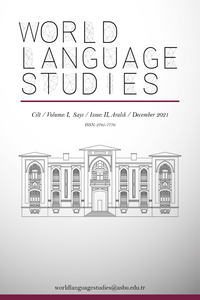Jean Rhys’ın Wide Saragasso Sea Adlı Romanında ‘Öteki’nin ‘Ötekiliği’
Jean Rhys, sömürge sonrası döneme ait 1966 basımlı Wide Sargasso Sea romanını, Charlotte Brontë’nin Viktorya Döneminde neredeyse bir yüzyıl önce yazdığı Jane Eyre romanına tepki olarak tekrar yazar. Amacı, Bronte’nin susturulmuş, yok sayılmış Bertha karakterinin sesini duyurmak, olanları bir de onun açısından yansıtmak istemesidir. Kendisine dayatılan toplumsal kimliğe karşı çıkan, oyuncak bebek gibi benliksiz bir kadın olmayı reddeden, en sonunda da üzerinde kurulan her çeşit baskıdan kurtulan bir kadını resmedip ‘tüm gerçekliği’ yansıtmak, madalyonun ‘öteki’ yüzünü’ de göstermek istemiştir. Yazar, üç bölüme ayırdığı romanında her bölümde farklı ‘ben’ anlatıcılar kullanarak geleneksel anlatım tarzını sorunsallaştırır. Metin içi metin kalıbını kullanır. Yazdığı bir ‘kurmaca’ metindir ve bu metin kendileri de ‘ben’ ve ‘öteki’ ikilemini deneyimleyen farklı ‘ben’ anlatıcıların sırayla anlattıkları hikâyelerinden oluşur. Rhys, bilinçli olarak ‘gerçek’ ve ‘kurmaca’ kavramları arasında belirsizlik oluşturur. Jane/Bertha ikili karşıtlığında yapıyı bozar ve ırk, sınıf ve cinsiyet bağlamında hep ‘öteki’ olan Bertha’yı merkeze alarak ‘öteki olma’ durumunu irdeler. Sonuç olarak, iki romanın birbirleriyle olan bağlantısı dolayısıyla, okura oluşturabileceği sonsuz anlam yaratma olasılığı sunulur. Romanda anlam sabit ve tek değil, çok katmanlı ve sonsuzdur.
Anahtar Kelimeler:
Ben/öteki, Gerçek/kurmaca ikilemleri, ‘Ben’lik arayışı.
The ‘Otherness’ of the ‘Other’ in Jean Rhys’s Wide Sargasso Sea
The aim of this study is to analyse a postcolonial novel Wide Sargasso Sea, written by Jean Rhys, in 1966 as a counter text to Charlotte Brontë’s Jane Eyre nearly a century after. Rhys rewrites the story of Rochester’s first wife Bertha, and gives her the voice she is denied. She intends to depict the ‘other’ side of the reality - the portrayal of a woman rebelling against the role imposed upon her, her objection to becoming a doll - like woman without any selfhood and at last her release from the repression of any kind. In the three fragmented worlds she constructs within the world of her novel, she problematizes the authorial figure shifting the reader’s attention away from one narrative to the other. Rhys challenges the realistic representation with her frame of texts within texts. Her fiction is rather a ‘verbal reality,’ constructed by two different narrators who are experiencing the strife between self and the other. Rhys, on purpose, creates an ambiguity in her novel and opens it to question by blurring the reality and fiction. She decentralizes the Jane/Bertha structure in Jane Eyre and inverts the privileged and the unprivileged elements in her attempt to unveil the ‘otherness’ of the ‘other’ in race, class and genderwise. As a result of the interrelatedness of the two novels, meaning is multiple, not fixed and always in the run.
Keywords:
Self/other, Reality/fiction dichotomies, ‘I’dentity search.,
___
- Brontë, C. (1985). Jane Eyre. London: Penguin Books. Bronte, C. 1 April 1843. [Letter from Charlotte Bronte to Ellen Nussey, 1843]. The Shakespeare Head Bronte – The Life and Letters, Volume I, p. 296. Bronte, C. 11 June [1851]. [Letter from Charlotte Bronte to Amelia Ringrose, [1851], The Shakespeare Head Brontë-The Life and Letters, Volume III, p. 245. Bronte, C. 28 July 1848. [Letter from Charlotte Bronte to Ellen Nussey, 1848], The Shakespeare Head Brontë-The Life and Letters, Volume II, p. 239. Derrida, J. (1976). Of Grammatology. (Trans. by Gayatri Chakravorty Spivak). Baltimore: John Hopkins University. Gilbert, S., & Gubar S. (1979). The Madwoman in the Attic: The Woman Writer and the Nineteenth Century Literary Imagination. New Haven and London: Yale University Press. Moglen, H. (1976). Charlotte Brontë: The Self Conceived. New York: WW Norton and Company Inc. Rhys, J. (1992). Wide Sargasso Sea. (Introduction by Francis Wyndham). New York: W.W. Norton & Company Inc. "Slavery Abolition Act 1833; Section LXIV" (http://www.pdavis.nl/Legis_07.htm). 1833-08-28.Retrieved from https://resources.saylor.org/wwwresources/archived/site/wpcontent/uploads/2011/05/Slavery-Abolition-Act-1833.pdf. Waugh, P. (1984). Metafiction: The Theory and Practice of Self-Conscious Fiction. London and New York: Methuen.
- Başlangıç: 2021
- Yayıncı: Ankara Sosyal Bilimler Üniversitesi
